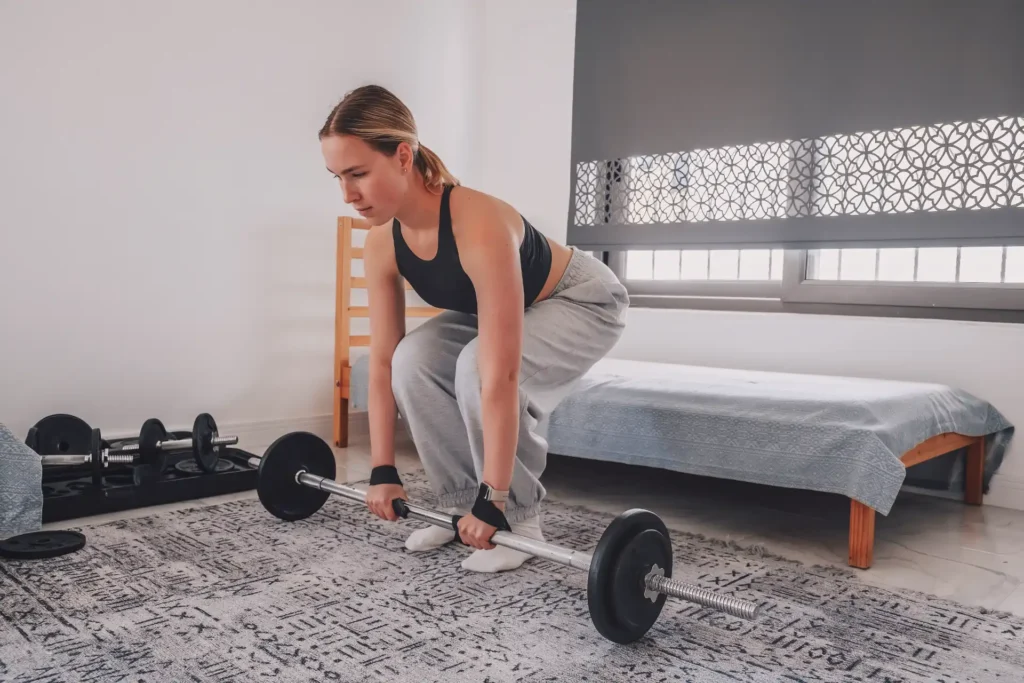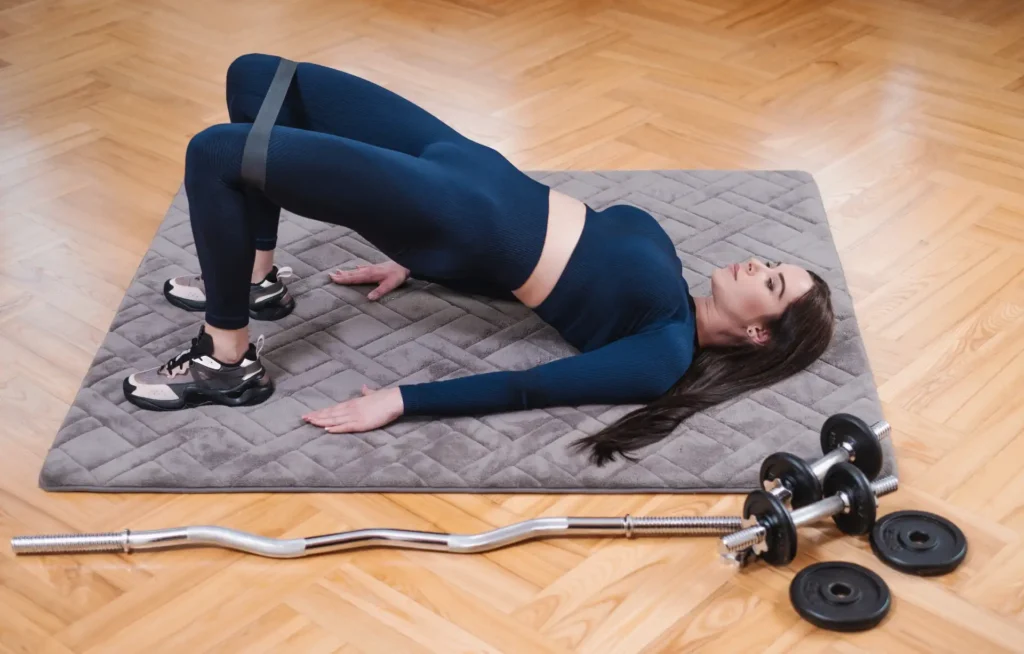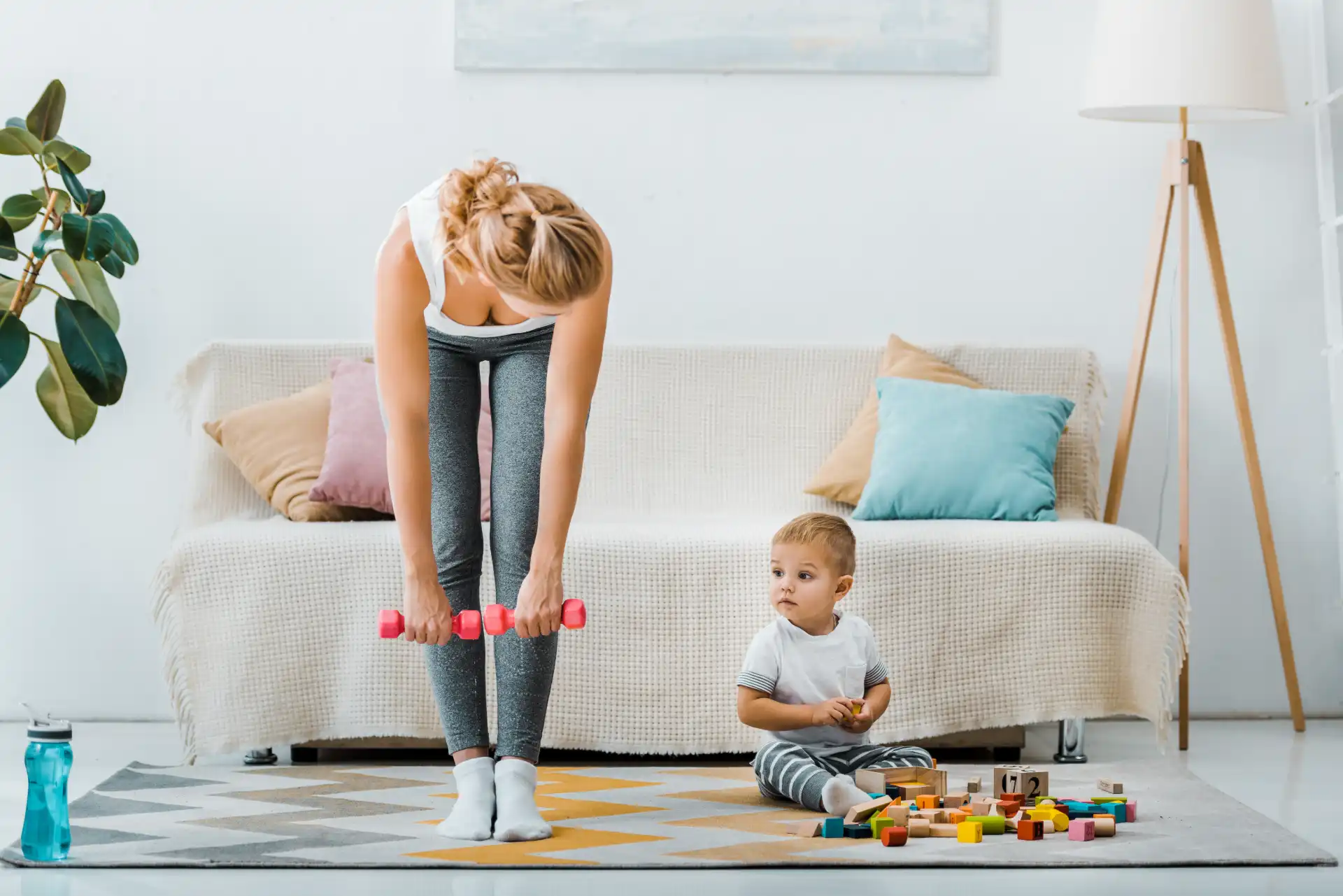If you’re looking for strength training for moms who run, this no-fluff 30-minute routine fits real life—school drop-offs, nap windows, and all — so you can run stronger, feel better, and stay injury-resilient.
As a busy mom, consistency beats perfection. The right strength training for moms who run — done 2–3 times per week — builds the power you need to hold form late in a run, resist common niggles, and keep showing up. Below you’ll find a simple framework, progressions, and plug-and-play templates that you can do at home with minimal equipment.
Before You Start
- Warm up briefly, lift with control, and stop any move that causes sharp pain.
- Postpartum or coming back from injury? Get the green light from your provider or a pelvic-health PT.
- Want more tips? See our categories:
Training Strategies and
Running Tips.
Why Runners Need Strength (Especially Moms)
- Injury resilience: Strong glutes, hamstrings, and calves help manage landing forces and improve running economy.
- Better posture & form: A stable trunk keeps your stride efficient when fatigue hits.
- Time efficiency: Short sessions compound over weeks — your “little but often” adds up.
Evidence note: Strength work supports performance and injury prevention in runners; see the
ACSM Position Stand on resistance training and
CDC adult activity guidelines.
The Core of the Plan: 5 Movement Buckets

Pick one exercise from each bucket (rotate weekly to keep it fresh):
1) Hinge (posterior chain power)
- Hip Hinge with Dumbbells (Romanian Deadlift)
- Single-Leg RDL (bodyweight or light DB)
- Hip Thrust or Elevated Glute Bridge
2) Squat / Lunge (single-leg control)
- Goblet Squat
- Reverse Lunge (DB optional)
- Split Squat (rear-foot elevated if you’re ready)
3) Push (posture & arm drive)
- Elevated Push-Up (hands on bench/couch)
- DB Floor Press
- Incline Push-Up with Tempo (3-0-3)
4) Pull (upper-back balance)
- One-Arm DB Row
- Band Row (seated or standing)
- Face Pull (band)
5) Calf / Plyo Primer (spring + durability)
- Standing Calf Raise (slow lower)
- Seated Calf Raise (DB on knees)
- Low-impact pogo or line hops (20–30 sec) if tolerable
Optional finisher: Anti-rotation core (Pallof Press), Dead Bug, or Side Plank 2×20–30 sec each side.
Your 30-Minute Template (No Guesswork)
Warm-Up (5 minutes)
- Marching Glute Bridge ×10
- World’s Greatest Stretch ×4/side
- Calf Pumps against wall ×15
- Band Monster Walk ×10 steps each way
Strength (20–22 minutes) — Do 3 rounds, ~45–60 sec rest between sets. Choose 5 moves (one per bucket):
- Hinge: Single-Leg RDL 8/side
- Squat/Lunge: Goblet Squat 8–10
- Push: Elevated Push-Up 8–12
- Pull: One-Arm DB Row 8–10/side
- Calf/Plyo: Standing Calf Raise 12–15 (3-sec lower)
Core + Reset (3 minutes)
Pallof Press 2×10/side → Box Breath 4×4 counts.
Done in ~30 minutes. If you only have 20, do 2 quality rounds.
Progression Made Simple (8 Weeks)
Turn one “progression knob” at a time:
- Load: +2–5 lb per DB once top reps feel solid.
- Range: Elevate front foot for split squats; deepen the hinge while keeping a neutral spine.
- Tempo: 3-1-1 on lowers (build strength fast).
- Volume: Add a 3rd set before adding more reps.
- Stability: Bilateral → unilateral (bridge → single-leg bridge).
| Weeks | Focus | Notes |
|---|---|---|
| 1–2 | Technique & tempo | Light loads, 2 sets, 8–10 reps |
| 3–4 | Load | Add weight where form is clean |
| 5–6 | Unilateral | Single-leg variations |
| 7–8 | Power primer | 20–30 sec pogo/line hops if symptom-free |
How to Fit Lifting Around Your Runs
General rule: spread hard things out. Adapt to your reality.
If you run 3 days/week
- Mon: Easy run + mobility
- Tue: Strength A (30 min)
- Thu: Strength B (30 min)
- Sat: Long run
If you run 4–5 days/week
- Lift on non-consecutive days, or after easy runs.
- Keep long-run day free of heavy lifting; do mobility only.
Related reading on our site:
Mom Fitness and
Running Essentials.
Two ready-to-use strength days
Strength A (Glutes & Posture)
- Hip Thrust 3×8–10
- Split Squat 3×8/side
- DB Row 3×8–10/side
- Elevated Push-Up 2–3×8–12
- Standing Calf Raise (3-sec lower) 2–3×12–15
- Pallof Press 2×10/side
Strength B (Single-Leg & Springs)
- Single-Leg RDL 3×8/side
- Reverse Lunge 3×8/side
- Band Row or Face Pull 3×12
- DB Floor Press 2–3×8–10
- Seated Calf Raise 2–3×12–15
- Side Plank 2×20–30 sec/side
Postpartum & Pelvic-Floor Notes
If you’re early postpartum or experiencing pelvic-floor symptoms (pressure, leaking, heaviness), prioritize:
- Shorter sets (6–8 reps) and slower tempo.
- Exhale on effort (e.g., exhale as you push up or stand).
- More supported options (e.g., elevated push-ups, bodyweight split squats).
Ease into plyometrics only when symptom-free. When in doubt, consult a pelvic-health physio (see NHS overview on staying active during and after pregnancy).
Minimal Equipment, Max Results

You can get far with just:
- 1–2 pairs of dumbbells (light & moderate)
- Long resistance band + mini-band
- Bench, sturdy chair, or couch for support
Upgrades: Adjustable DBs, a hip-thrust pad, and a yoga mat.
Time-Crunch Tweaks (10–15 Minutes)
On chaotic days, micro-dose strength. Pick one from each category and run a timed circuit (10 minutes):
- Single-Leg RDL 6/side
- Split Squat 6/side
- Band Row 10
- Calf Raise 12
Set a timer and cycle through as many quality rounds as you can without rushing.
Common Mistakes & Quick Fixes
- Collapsing knee in lunges: Think “knee tracks over middle toes,” keep hips square.
- Low-back pinch on hinges: Push hips back, slight knee bend, keep ribs stacked over pelvis.
- Rushed reps: Own the lowering phase—this is where strength is built.
- All-or-nothing mindset: Two 20-minute sessions beat one “perfect” session that never happens.
Sample 4-Week Starter Plan
Week 1–2: Strength A + Strength B, 2×/week. Keep reps clean, moderate load.
Week 3: Add one set to hinges and split squats.
Week 4: Increase load slightly or add a 3-second lower.
Keep going: Recycle exercises, change the variation (e.g., RDL → single-leg RDL), and track one metric: load, reps, or tempo.
References & Helpful Resources
- American College of Sports Medicine (ACSM): Progressive Models in Resistance Training
- CDC: Physical Activity Basics — Adults
- NHS: Keeping Active During and After Pregnancy
Disclaimer: This article is educational and not medical advice. Consult your healthcare provider or a qualified coach if you have concerns.


